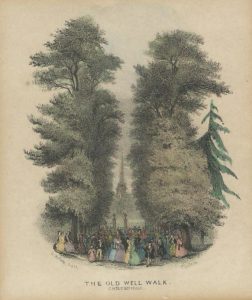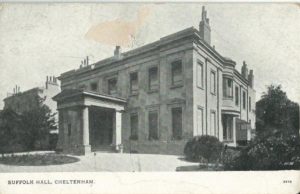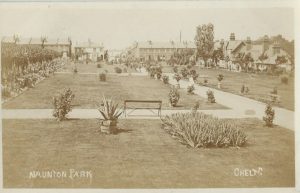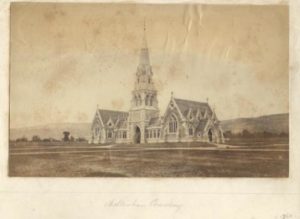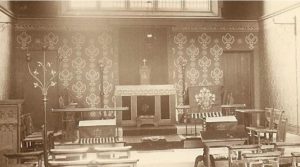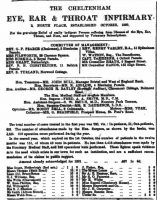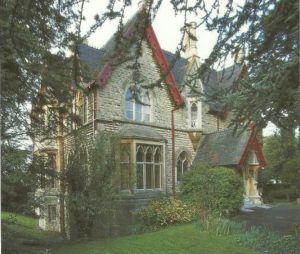THE MASTERS OF THE CEREMONIES IN CHELTENHAM by Brian Torode
The story of how Cheltenham’s spa waters were discovered in 1716 is well known and by 1740 they had been acclaimed superior to any in the country. This claim probably started the fashion of coming to Cheltenham for health restoring purposes and by 1748 the town’s annual visitor numbers had reached 700. In order to entertain these early visitors to the spa, the usual local provincial sports and pastimes such as bowls, riding and hunting were made available and there was a small theatre which had been opened in a converted malthouse. Balls and card parties also took place in the public rooms attached to the wells.
You may use the material on this website for your own private research purposes but not for publication in any format.
Text is copyright of Cheltenham Local History Society and/or the author(s), and all illustrations are copyright to the copyright owners. Neither text nor illustrations may be reproduced, stored in a retrieval system or transmitted by any means without the prior permission in writing of the owner or owners. We apologise if any material infringes copyright or has not been acknowledged. The Society will gladly acknowledge any omissions, if informed.
No material from this website may be reproduced in any format without permission from the copyright holder(s) and due acknowledgement of the same. Please use our Contact Form for any queries.
SUFFOLK LAWN AND LYPIATT TERRACE by Brian Torode
Perhaps one of the most socially important people in Cheltenham in the late eighteenth century was John de la Bere, Steward to the Lord of the Manor, and a Cheltenham solicitor who lived in an impressive house in the High Street near to where the Beachwood Arcade stands in 2004. John de la Bere was a wealthy man and he and his son owned much land in Cheltenham and its outlying area south of the town in what is today Montpellier and Lansdown.
You may use the material on this website for your own private research purposes but not for publication in any format.
Text is copyright of Cheltenham Local History Society and/or the author(s), and all illustrations are copyright to the copyright owners. Neither text nor illustrations may be reproduced, stored in a retrieval system or transmitted by any means without the prior permission in writing of the owner or owners. We apologise if any material infringes copyright or has not been acknowledged. The Society will gladly acknowledge any omissions, if informed.
No material from this website may be reproduced in any format without permission from the copyright holder(s) and due acknowledgement of the same. Please use our Contact Form for any queries.
NAUNTON NOTES AND QUERIES by Brian Torode
In the middle ages, Cheltenham was divided into three tithings- in simple terms, this means districts or units of land (hamlets as Atkyns calls them) comprising ten households where each household was responsible for the actions of the others. Of course a tithing of ten households could in practice number between 50 and 100 people. The three which comprised Cheltenham were (i) Cheltenham itself; (ii) Arle and Alstone; (iii) Westal, Naunton and Sandford.
You may use the material on this website for your own private research purposes but not for publication in any format.
Text is copyright of Cheltenham Local History Society and/or the author(s), and all illustrations are copyright to the copyright owners. Neither text nor illustrations may be reproduced, stored in a retrieval system or transmitted by any means without the prior permission in writing of the owner or owners. We apologise if any material infringes copyright or has not been acknowledged. The Society will gladly acknowledge any omissions, if informed.
No material from this website may be reproduced in any format without permission from the copyright holder(s) and due acknowledgement of the same. Please use our Contact Form for any queries.
CHELTENHAM CEMETERY AND ITS INHABITANTS by Brian Torode
Everyone used to have right of burial in their own parish- or in other parishes if they could afford a donation! – but Cheltenham’s Parish Churchyard was nearly full by 1830, so 10 acres of land were bought at the lower end of the High Street and laid out 1830-31. The Greek Chapel design was by Charles Paul of Paul & Sons and cost £600. By 1850s this Old Ground was almost at capacity level and a new site was desperately needed.
You may use the material on this website for your own private research purposes but not for publication in any format.
Text is copyright of Cheltenham Local History Society and/or the author(s), and all illustrations are copyright to the copyright owners. Neither text nor illustrations may be reproduced, stored in a retrieval system or transmitted by any means without the prior permission in writing of the owner or owners. We apologise if any material infringes copyright or has not been acknowledged. The Society will gladly acknowledge any omissions, if informed.
No material from this website may be reproduced in any format without permission from the copyright holder(s) and due acknowledgement of the same. Please use our Contact Form for any queries.
CHELTENHAM CATHOLIC APOSTOLIC CHURCH by Richard Barton
Some years before his death, Brian Torode was researching the history of the Catholic Apostolic Church in Cheltenham. He was in communication with His Beatitude Patriarch Seraphim who informed him that addresses and lectures were held in the town during the years 1874 and 1875. According to the 1872 Catholic Apostolic Church Address Book the congregation held meetings at York Rooms near High Street. The Deacon at that time was Benjamin Cam Norton of Gainsborough House, Bath Road.
You may use the material on this website for your own private research purposes but not for publication in any format.
Text is copyright of Cheltenham Local History Society and/or the author(s), and all illustrations are copyright to the copyright owners. Neither text nor illustrations may be reproduced, stored in a retrieval system or transmitted by any means without the prior permission in writing of the owner or owners. We apologise if any material infringes copyright or has not been acknowledged. The Society will gladly acknowledge any omissions, if informed.
No material from this website may be reproduced in any format without permission from the copyright holder(s) and due acknowledgement of the same. Please use our Contact Form for any queries.
CHELTENHAM EYE, EAR AND THROAT INFIRMARY 1889 – 1902 by Brian Torode
The Cheltenham Eye, Ear and Throat Infirmary was established at 2, North Place, Cheltenham in 1889. It was a Public, Charitable Institution for the “gratuitous relief of really indigent persons suffering from diseases of the eye, ear, throat and nose.” The Infirmary was governed by the annual subscribers who elected a committee of seven, comprised mainly of local gentry and professionals.
You may use the material on this website for your own private research purposes but not for publication in any format.
Text is copyright of Cheltenham Local History Society and/or the author(s), and all illustrations are copyright to the copyright owners. Neither text nor illustrations may be reproduced, stored in a retrieval system or transmitted by any means without the prior permission in writing of the owner or owners. We apologise if any material infringes copyright or has not been acknowledged. The Society will gladly acknowledge any omissions, if informed.
No material from this website may be reproduced in any format without permission from the copyright holder(s) and due acknowledgement of the same. Please use our Contact Form for any queries.
CHELTENHAM LADIES’ COLLEGE – Development of the Bayshill Site by Brian Torode
A time-line of the development of the site by John Middleton and his successors.
You may use the material on this website for your own private research purposes but not for publication in any format.
Text is copyright of Cheltenham Local History Society and/or the author(s), and all illustrations are copyright to the copyright owners. Neither text nor illustrations may be reproduced, stored in a retrieval system or transmitted by any means without the prior permission in writing of the owner or owners. We apologise if any material infringes copyright or has not been acknowledged. The Society will gladly acknowledge any omissions, if informed.
No material from this website may be reproduced in any format without permission from the copyright holder(s) and due acknowledgement of the same. Please use our Contact Form for any queries.
SOME CHELTENHAM BUILDINGS – mainly designed by John Middleton and William Hill Knight, by Brian Torode
A selection of lesser-known Cheltenham buildings designed by John Middleton, William Hill Knight and others, including St John’s Lodge in Tivoli Circus, Dorothea Beale’s house, St Hilda’s College, Western Road, The Ladies’ College Sanatorium, Westholme, Eastholme, Dewerstone, and Cheltenham College Boarding Houses Hazelwell, Leconfield and Cheltondale.
You may use the material on this website for your own private research purposes but not for publication in any format.
Text is copyright of Cheltenham Local History Society and/or the author(s), and all illustrations are copyright to the copyright owners. Neither text nor illustrations may be reproduced, stored in a retrieval system or transmitted by any means without the prior permission in writing of the owner or owners. We apologise if any material infringes copyright or has not been acknowledged. The Society will gladly acknowledge any omissions, if informed.
No material from this website may be reproduced in any format without permission from the copyright holder(s) and due acknowledgement of the same. Please use our Contact Form for any queries.
CHELTENHAM MEMORIES transcribed by Brian Torode
Mrs Watts: War memories 1914-1918, and Mr Flint, born 1902. Resident at The Reddings, Hatherley, and an authority on its history.
Handwritten manuscript papers found in a box of books – no name of scribe but the box formed part of the contents of the estate of the late June Hamblett, formerly of Cavendish House, and author of an article in CLHS Journal 3 (1985).
You may use the material on this website for your own private research purposes but not for publication in any format.
Text is copyright of Cheltenham Local History Society and/or the author(s), and all illustrations are copyright to the copyright owners. Neither text nor illustrations may be reproduced, stored in a retrieval system or transmitted by any means without the prior permission in writing of the owner or owners. We apologise if any material infringes copyright or has not been acknowledged. The Society will gladly acknowledge any omissions, if informed.
No material from this website may be reproduced in any format without permission from the copyright holder(s) and due acknowledgement of the same. Please use our Contact Form for any queries.

